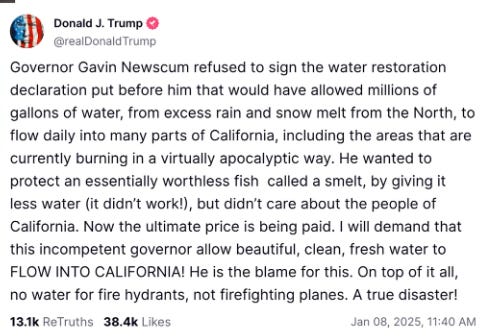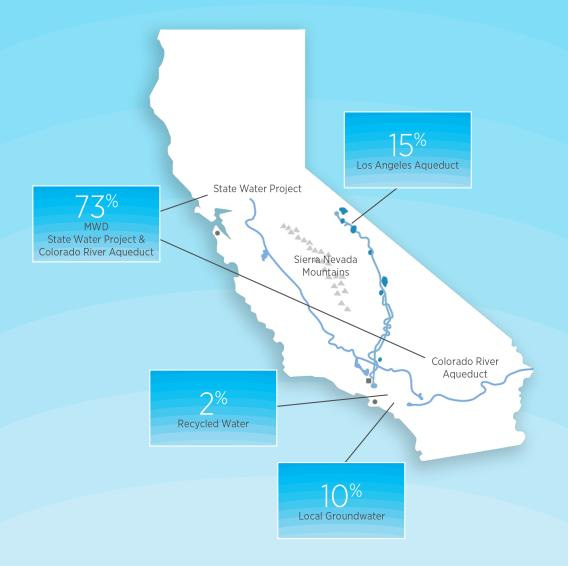If You're Gonna "Fact-Check" Make Sure You Know the Facts Yourself.
Looking at you, Krassenstein brothers
The “fact-checkers” are Trump in their sights over his various political jabs and complaints towards California and its leadership amid Southern California’s horrific fires. One of Trump’s claims surrounds the controversy of the Delta Smelt, a small endangered fish endemic to the Sacramento-San Joaquin Delta in Northern California.
Environmentalists and ecologists argue the Delta Smelt is not only an indicator species of the area but is on the verge of going extinct. One-hundred fifty plus years of developing the Delta and adjacent areas largely farming along with diverting water to urban areas are seen as the causes of the issue. Needless to say, occasionally water intended for agricultural and urban use is in some years and during some periods allocated to instead run straight into the delta with a goal of maintaining the appropriate conditions for the Delta Smelt to survive. Since much of the Delta lies at or even in parts below sea level, the nearby San Francisco Bay, which is connected directly to the Pacific Ocean means salt water infiltrates inland while in parts of the Delta the mean level of the land is sinking. The salinity of the water in the smelt’s habitat changes each year with the differences in rainfall and snowmelt and smelt are neither pure freshwater nor pure saltwater fish. This makes them incredibly finicky creatures since the Delta’s salinity changes often depending on the amount of freshwater rainfall and snowmelt upstream of the delta. Environmentalists and ecologists also argue urban and agricultural use of water contributes significantly to their demise too, along (of course) with climate change, hence their desires to curb such water use. Smelt also get caught in the pumps that remove the water from the delta.
Needless to say, the Delta Smelt represents one of the classic water use conflicts in California and the butting of heads between environmentalists and ecologists, California’s agricultural industry which serves as the breadbasket of much of the country, and the rest of the state’s population especially in the urban areas. These urban areas include the water scare region of Southern California, home to millions including the second largest city in the country, Los Angeles.
Trump’s claim is that part of the reason Los Angeles, and to some extent the region, doesn’t have enough water which at this hot moment has to do with fighting the region’s horrific fires is because Gov. Newsom has not allowed fresh water to flow from the northern part of the state down to the urban areas in the southern part of the state.
(For as much as I’m not a fan of Newsom and am hoping this entire debacle results in his downfall, he hasn’t always fallen in line with the environmentalists trying to protect the Delta Smelt.)
Naturally however, Trump’s bombastic post has brought the “fact-checkers” out and about.
Vox, as part of a sweeping “fact check,” wrote:
Regulations to prevent the delta smelt from going extinct have nothing to do with LA’s catastrophic fires. For one, the problem wasn’t a lack of water. Plus, most of the city’s water doesn’t even come from Northern California, as Alastair Bland reported in CalMatters.
And their source, Alastair Bland from CalMatters went into even more detail.
Trump appeared to be referring to water imported south from the Bay-Delta, fed by Northern California rivers and snowmelt. But most Los Angeles water does not come from Northern California. It comes via the city’s 112-year-old aqueduct that runs from the Owens Valley east of the Sierra Nevada, not the Delta, as well as groundwater. The city also imports water from the Metropolitan Water District, which relays water from the Colorado River and Delta to numerous local agencies. The city was the main motivating force for the building of the Colorado River Aqueduct in the 1930s.
Then there’s the Krassenstein Twins with this doozie:
“Water Management: The Delta Smelt Myth
One of the most repeated (and baseless) claims is that maintaining river flows to protect endangered species like the Delta Smelt in the Sacramento-San Joaquin Delta is causing water shortages in Los Angeles.
This is flat-out false. LA’s water doesn’t even come from the Delta. It’s sourced from the Colorado River, local groundwater, and major reservoirs like Castaic Lake.
In fact, reservoir levels are healthy:
Shasta Lake is at 78% capacity.
Lake Oroville is at 71% capacity.
Castaic Lake, a key supplier for LA, is over 70% full.
Blaming environmental protections for water shortages is a distraction from real issues like aging infrastructure in Los Angeles and increased urban demand. The Delta Smelt isn’t the culprit, and neither is Governor Newsom.”
For what it’s worth, both Vox and Alastair Bland get it right but the Krassenstein Twins obnoxiously have little clue of what they’re talking about. I don’t like giving credit to Vox, as ironically they’re a huge source of what is blatent misinformation on topics including renewable energy and gun violence. (See Handwaving Freakoutery ‘s work for that last one.)
Both Vox and Bland is they could have strengthened their argument further by actually providing approximate numbers or some sort of scale as to how much water does or doesn’t come from the Sacramento-San Joaquin Delta. The Krassenstein’s fact check has that issue too but it’s not the top problem with their “fact check.”
Since all three of the fact checks surround the city of Los Angeles’ water supply, it’s worth going into exactly where the city gets it water. An Angelino resident pays his or her water bill to the Los Angeles Department of Water and Power (LADWP), a behemoth organization worthy of its own pieces.
LADWP get its water from three major sources:
Los Angeles Aqueduct - which drains parts of the Eastern side of the Sierra Nevada and Owens Valley via LADWP owned infrastructure along with groundwater pumping in the area.
The Colorado River via the Metropolitan Water District of Southern California (MWD)
The California State Water Project via the Metropolitan Water District of Southern California (MWD) - this is the only source of water that comes from the Delta.
The rest comes from local groundwater sources. LA also sources some of their water from groundwater and water recycling, but these are relatively small numbers.
LADWP has a handy map of the percentage of their water sources here also produced below:
MWD’s water sources are shown on their website with a similar image.
We can take both sources and combine them onto one single source to actually figure out whether Vox via CalMatters’ statements are correct.
The California State Water Project or SWP (21.90%) connects the Sacramento-San Joaquin Delta’s water to the Southern Part of the state along with other urban areas Its water from this infrastructure that pertains to any claim surrounding the great Delta Smelt controversies.
This is what Trump’s claim relies on and also the claims of these “fact-checkers.”
Now let’s get back to the Krassenstein brothers. They write:
LA’s water doesn’t even come from the Delta. It’s sourced from the Colorado River, local groundwater, and major reservoirs like Castaic Lake.
For those who can do math, 21.9% is not zero.
Now for the next part where they blabber off three reservoirs in the state.
Shasta Lake is at 78% capacity.
Lake Oroville is at 71% capacity.
Castaic Lake, a key supplier for LA, is over 70% full.
Shasta Lake impounds the Shasta River, a tributary of the Sacramento River whose ultimate water ends up, oops in the Sacramento-San Joaquin Delta. Shasta Lake is part of the Central Valley Project, a similar set of water infrastructure to the CA State Water Project but is owned by the Bureau of Reclamation. It provides water primarily to agriculture in the Central Valley.
Lake Oroville impounds the Feather River, another tributary of the Sacramento River but unlike Shasta, Lake Oroville is part of the California State Water Project or that 21.9%.
Castaic Lake is far closer to LA nestled up in the mountains north of the city. While its dam impounds Castaic Creek, the majority of the reservoir’s water comes from the final branch of guess what…the California Aqueduct which is, oops, the CA State Water Project. The only part here the Krassensteins get correct is that it’s “a key supplier to LA,” but that supply of water comes from the very source they insist provides exactly zero of LA’s water.
So in other words, the Krassensteins are talking out their you-know-whats on this particular topic.
Now here’s an unknown - how much do delta smelt water diversions affect urban uses of SWP water? Answering this question should really have been at the crux of any “fact-check.”
One would think given all the “big data,” hundreds of stream and river gauges along California’s rivers, hundreds of flow meters on pipes and aqueducts, and the entire fact this water is bought and sold on markets where all this should theoretically be tracked, there’d be information out there on this. Perhaps my Google skills are rusty, but I surprisingly had a hard time figuring this out.
Here was the best I could do which still falls short.
Per The Economy of the State Water Project Clean, Reliable, and Affordable Water for California by David Sunding, Ph.D., Oliver Browne, Ph.D., and Zhaolong Jerry Zhu published in 2023:
Southern California receives about 1.35 million acre-feet of State Water Project water per year on average, or around 54% of all water deliveries. Around 90% of all State Water Project water use in Southern California is in the urban sector.
The California Natural Resources Agency in 2013 released a document called “Questions and Answers about Water Diversions and Delta Smelt Protections,” and in there is a specific question pertaining to curtailment.
Who is affected by the pumping curtailment?
The water projects are the federal Central Valley Project (CVP), which primarily serves agricultural water districts on the west side of the San Joaquin Valley but also serves some urban customers, including the city of Tracy; the other is the State Water Project (SWP), which primarily serves urban water districts in Southern California, the southern San Francisco Bay Area including Silicon Valley but also urban and agricultural districts in Kern County. Together these projects provide water to about three million acres of farmland and at least a portion of the supply used by about 25 million Californians. Experts estimate the Delta water supply lost to the CVP and SWP from Nov. 1 to Jan. 31 at roughly 700,000 acre-feet. That is approximately enough to supply 1.4 million households for a year. Under existing operating rules, the CVP and SWP divert approximately 4.7 million acre-feet a year from the Delta.
Note, this is 12 year old information and combines both CVP water (which does not divert to Southern California) and SWP (which does) but here they indicate this diversion is roughly 15% if we’re to take the first source from 2023 and assume no changes in the past ten years. These diversions appear to only take place a part of the year. For farmers who rely on this single source of water (and/or groundwater pumping to supplement), this is understandably an issue for them. For urban areas such as those in Southern California who have a more diverse option for water? Maybe not so much. It’s hard to quantify though without actual data and it seems as if neither Trump nor these “fact-checkers” are interested in finding out.







What difference does it make at this point?
The question remains; why is there no water for fire fighting in an area prone to serious fires?
The whole thing smelt fishy……